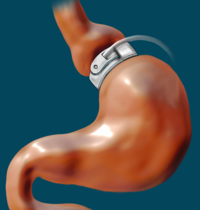
Photo from wikipedia
Objective: Knowing the degree of gastric fullness is critical in determining the potential risk of pulmonary aspiration prior to urgent or elective intubation. This study aims to investigate the role… Click to show full abstract
Objective: Knowing the degree of gastric fullness is critical in determining the potential risk of pulmonary aspiration prior to urgent or elective intubation. This study aims to investigate the role of ultrasound in predicting the gastric volume accurately. Methods: 176 patients who underwent upper gastric endoscopy after 12-hour fasting were examined by gastric US. The patients were randomly divided into 6 groups according to the volume of ingested semifluid meal: (1) empty stomach (no volume), (2) 50 mL, (3) 100 mL, (4) 200 mL, (5) 300 mL, and (6) 400 mL. Antral cross-sectional area (CSA) was measured by US after each ingestion. Results: We found a strong linear correlation between antral CSA and gastric volume up to 200 mL. The diagnostic performance of ultrasound was found to be more powerful in the supine position than in the right lateral position. A new mathematical model was established to predict gastric volume. The threshold value for antral cross-sectional area at risk of pulmonary aspiration was determined as 3.1 cm2 by sonographic measurement. Conclusion: Ultrasonography could be preferred to gastric endoscopy or scintigraphy in terms of non-invasiveness and easiness, although it still merits further investigation.
Journal Title: Turkish Journal of Anaesthesiology and Reanimation
Year Published: 2022
Link to full text (if available)
Share on Social Media: Sign Up to like & get
recommendations!